Smerinthus cerisyi
smeh-RIN-thuhsMsir-EE-see-eye
Kirby, 1837
One-eyed Sphinx or Cerisy's Sphinx
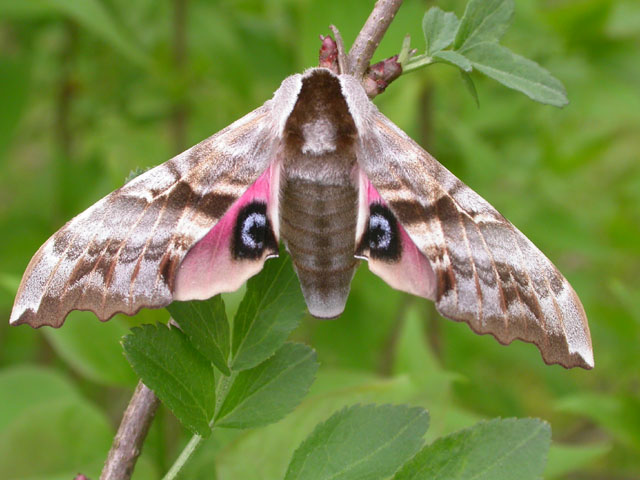
|
|
Updated as per personal communication with Dave Gabon, March 23, 2008 Updated as per The Hawk Moths of North America, 2007, James P. Tuttle, March 2008 |

This site has been created by Bill Oehlke.
Comments, suggestions and/or additional information are welcomed by Bill. I am building a data base of collecting data so please send
species, date and location of any Sphingidae sightings to
Bill Oehlke.
TAXONOMY:Family: Sphingidae, Latreille, 1802 |
This species has been taken in southeastern Alaska: Haines vicinity, Skagway, and in the Yukon.
At one time Smerinthus ophthalmica was treated as a synonym of S. cerisyi, but ophthalmica has been resurrected to full species status (2010) and replaces cerisyi in most of the Pacific Northwest. I have moved many of the images and links previously on this page to the ophthalmica file.
Derek Bridgehouse sends the following image with commentary: "I was pinning out a couple Smerinthus cerisyi .. comparing Eastern phenotypes to Prairie and wondering why noticeable size differential?"
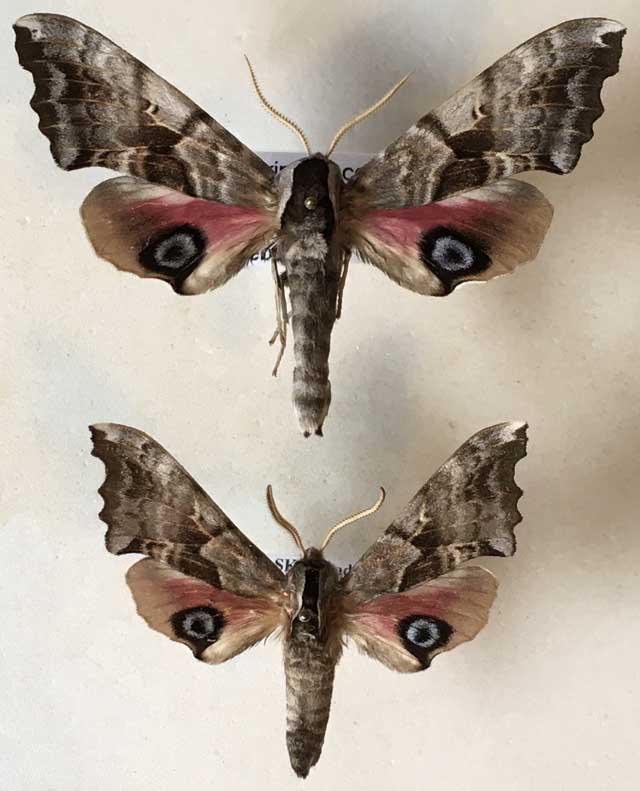
Smerinthus cerisyi borealis, courtesy of Derek Bridgehouse,
Quebec top, SK bottom, Both males; Be interesting to compare females too ..
I replied to Derek, that although the size differential appears to be consistent, to my knowledge the smaller phenotype is still treated as a synonym of cerisyi rather than as a subspecies. Perhaps that will change with DNA barcoding analysis.
Here on Prince Edward Island our local Antheraea polyphemus population is noticeably smaller than the specimens I encountered in my youth in rural New Jersey, and I have seen real monsters from Pennsylvania. Our local weather can be unpredictable. If we have a late spring and an early fall, there might be a survival advantage to a smaller race that requires less larval feeding time to reach maturity. Oak trees were at one time more plentiful than they are today, but they are making a comeback now that they are not used for ship building. Perhaps scarcity of a preferred host has something to do with smaller size. I rear most of my polyphemus here on red maple, but also have very good success on white paper birch and have also reared them on pin cherry.
Smerinthus cerisyi antennae typically rest alongside head and thorax and forewings generally conceal hindwings.
Tim Dyson sends this female (below) from Peterborough, Ontario, June 13, 2005.
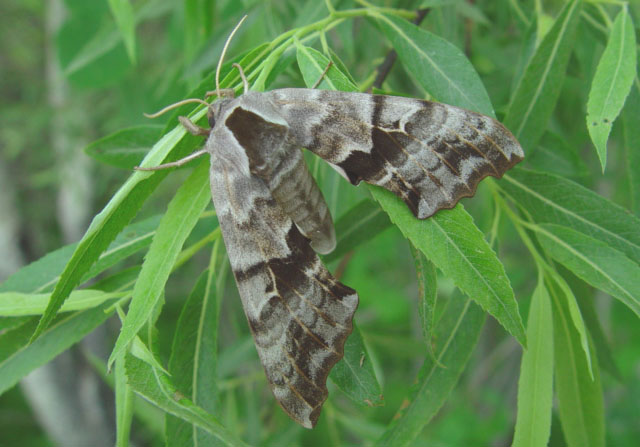
Visit Smerinthus cerisyi male, Blind River area of northern Ontario, May 28, 2012, Ellen Parker.
James P. Tuttle indicates he believes this species has only a single generation each year, although "the range of dates from farther south is broadly skewed."
Smerinthus cerisyi is probably the Island's most common Sphingidae and LIVESTOCK is readily available in the fall.
Reared stock, stored in refrigerator at 48 F from October until May, began eclosing nine days out of storage at 68 F.
Moths eclose after dark, usually around midnight.
On the other hand, Robert Jindra has seen some Sphingidae emerge in their subterranean chambers and then climb to the surface through their original tunnel. In June of 2012 Zana Goulding sent me a nice image of underside of a Smerinthus cerisyi male. Zana writes, "Hi Bill, found this one on the garage today, it was too high up for me to get any real good shots. It did appear to have some sort of eye and pinkish color on the underwing; maybe 1.5 inches long in the body."
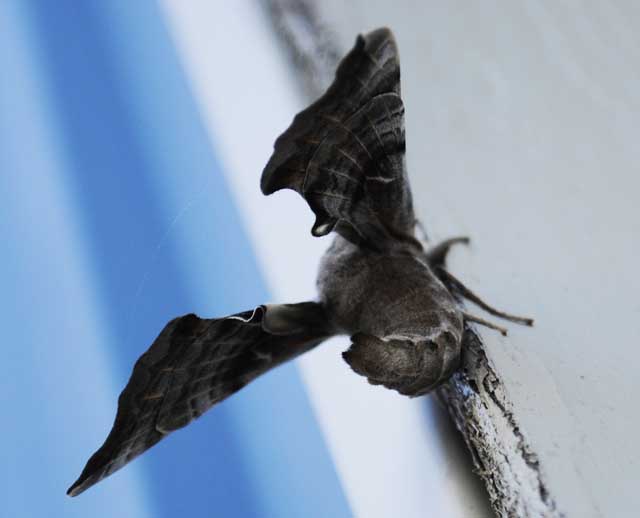
Smerinthus cerisyi/ophthalmica ?? male (verso), Spokane, Spokane County, Washington,
June 24, 2012, courtesy of Zana Goulding
Females extend a scent gland from the posterior of the abdomen to lure in the night flying males. The male aligns himself at 180 degrees from the female so that their heads are in opposite directions during pairing, which continues until the following evening.Females, with a body girth much greater than that of males, will mate the same night as they have eclosed. Resting males arch the lower third of their abdomens upwards towards the thorax while females rest with the abdomen uncurled. Smerinthus cerisyi, female, Peterborough, Ontario, June 13, 2005, courtesy of Tim Dyson. | 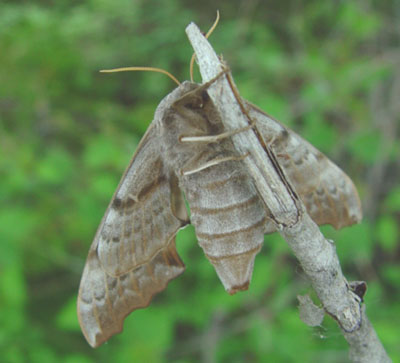 |
Both sexes rest with wings parallel to the plain of the resting surface. Note the filiform antennae and "turkey baster" abdomen of the female, above.
Females have a relatively short tongue length of 5 mm and readily deposit all their eggs (100+) on the insides of brown paper grocery bags or sandwich bags within 5 or 6 days without any feeding.Spherical, pale green eggs are difficult to distinguish from other Sphingidae eggs. Eggs, which are usually deposited singly or in pairs, incubate for six to eight days at 70 F and tiny larvae readily accept various species of willow and poplar. | 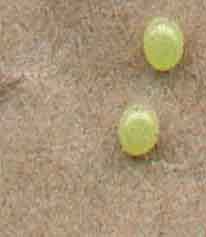 |
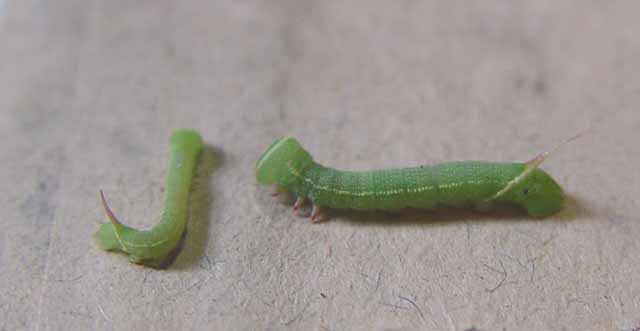
One-two day old Smerinthus cerisyi courtesy of Tim Dyson.
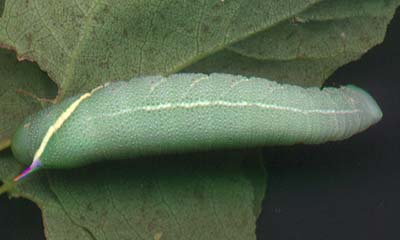 | Larval growth is rapid (3-4 weeks) on either willow or poplar and this species readily pupates under artificial conditions, i.e., dark enclosure, bottom filled with loose tissue or paper towelling. Pupation usually occurs within 4 to 5 days.Scans by Bill Oehlke |
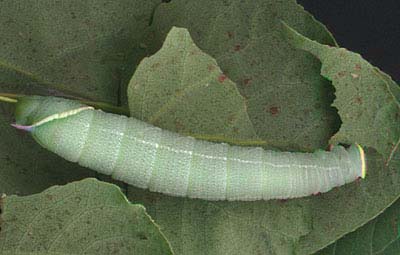 | Cerisyi larvae greatly resemble modesta larvae, both being pale green, with granular skin, pale lateral diagonal lines, faint red spiracular circles, and very pale longitudinal lines running from the head to a more pronounced anal diagonal line.Modesta have a distinct pink head while cerisyi have green heads bounded dorsally with a pale yellow inverted "V". |
Visit Smerinthus cerisyi larva and adult moth, Door County, Wisconsin, courtesy of Janice Stiefel.
Larvae of both species are extremely strong and usually thrash about when disturbed. The anal horn of the mature cerisyi is pink with a blue dorsal base. Sometimes the horn is blue.
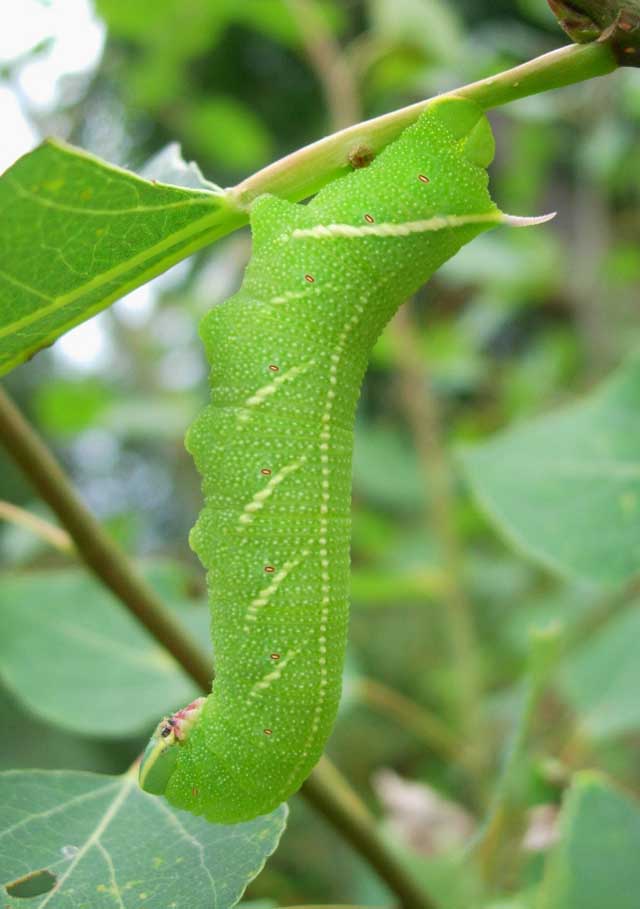
Smerinthus cerisyi fifth instar, British Columbia,
courtesy of Ben Trott.
After allowing the eggs a day or two to harden, I gently remove them with my thumbnail to 414 ml (about 1/2 quart or 1/2 liter) ziploc plastic tubs. I use a different tub for each evening's eggs and record date on tub. I put no moisture in with the eggs and snap the lids shut. Larvae usually emerge in the morning 6-8 days after deposition. The eggs can be left affixed to cut outs of brown paper bag. No food is put in tubs until after larvae have begun emerging. (Good idea not to have unhatched eggs in container when inserting food).
A few poplar or willow leaves left affixed to twig are placed in with emerged larvae. After two or three days of feeding, larvae are moved outdoors to sleeved willow or poplar branches. I typically use six-foot-long, frass-slotted Remay sleeves for cerisyi (25 larvae/sleeve).
Frass slot is located at lower end of sleeve and fastened shut with a clothespin. The open end of the sleeve is tied shut with some cotton string after I have placed the tiny larvae, still clinging to indoor feeding twig, inside the sleeve. The twig is gently rested on upper foliage inside sleeve. Frass is removed as needed by unclipping clothespin.
Instead of doing all the extra work of moving eggs, now (2005) I cut a hole in the bottom of the brown paper (egg) bag and thread a live poplar branch through the bag and out the hole (a day or so before eggs hatch) and let the larvae crawl onto the foliage themselves. This all takes place inside a remay sleeve over a poplar branch. When larvae are nearly full grown or begin to leave foliage (3-4 weeks) and crawl around on sleeve, I bring them indoors and put them in 2-5 gallon clear plastic tubs with cut food. These larvae have strong mandibles and desire to leave host to pupate underground is so strong, that they will actually chew holes through Remay cloth if not removed.
When larvae leave food in plastic tubs, I gently lift larvae and place them in lidded buckets that have three or four layers of paper towels on the bottom. Buckets are placed in warm, dark spots, and pupation occurs in 4-5 days under paper towelling.Tim Dyson (pupa image to right) uses a medium of leaf litter for pupation. Various mixtures of peat, sand, soil, litter are also fine. | 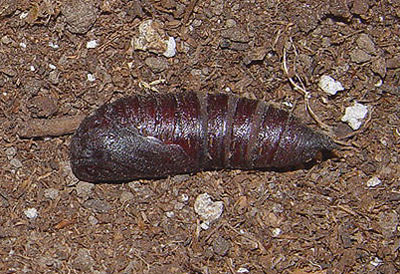 |
After pupae have hardened for several days, I place them side by side on top of a few sheets of folded paper towels in same ziploc containers I used for eggs. Here on P.E.I. cerisyi seem to have only a single generation. Pupae are stored at room temperature in lidded containers until they go in fridge in October for winter storage. One or two drips/drops of water in the container at time of entry to fridge is all the care that is needed over the winter. I have a separate mini-fridge that I use for Sphingidae pupa storage and keep temperature there around 40-45.
Return to U. S. A. Table
Return to Main Sphingidae Index
Return to Smerinthini Tribe
Enjoy some of nature's wonderments, giant silk moth cocoons. These cocoons are for sale winter and fall. Beautiful Saturniidae moths will emerge the following spring and summer. Read Actias luna rearing article. Additional online help available.
Use your browser "Back" button to return to the previous page.
This page is brought to you by Bill Oehlke and the WLSS. Pages are on space rented from Bizland. If you would like to become a "Patron of the Sphingidae Site", contact Bill.
Please send sightings/images to Bill. I will do my best to respond to requests for identification help.